This past week I had the opportunity to visit the 9/11 Memorial site in Manhattan. After a short ride on a commuter rail, I jumped on the downtown A train to the Fulton Street station, stopped at a Starbucks for a tall iced-coffee, and began weaving my way eastward.
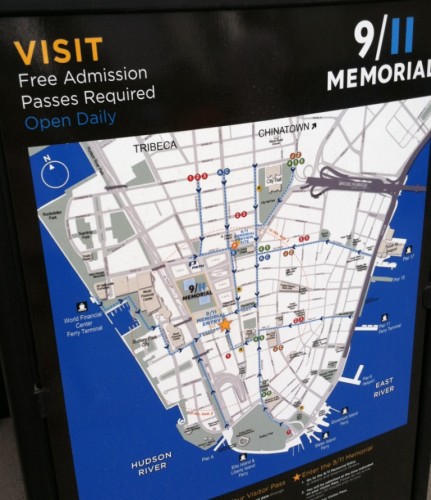 This was not the first time that I had been to the area. As a child, I remember standing under the draping shadows of the twin towers – the two monolithic structures that symbolized New York City. Later, as an adult, I recall dining at Windows on the World, the restaurant that operated on the 106th floor of the North Tower. Gazing out of its windows, the restaurant appeared to be floating, somewhere between the solid misty darkness of the night sky and the twinkling of the endless city lights below. From that height, it seemed as if the city had stolen the stars right out of the sky.
This was not the first time that I had been to the area. As a child, I remember standing under the draping shadows of the twin towers – the two monolithic structures that symbolized New York City. Later, as an adult, I recall dining at Windows on the World, the restaurant that operated on the 106th floor of the North Tower. Gazing out of its windows, the restaurant appeared to be floating, somewhere between the solid misty darkness of the night sky and the twinkling of the endless city lights below. From that height, it seemed as if the city had stolen the stars right out of the sky.
That was New York City for me: a majestic and magical star. I grew up on the banks of the Hudson River with the city as a backdrop and playground. It was everything to me. When I saw the skyline for the first time after 9/11, it was uncomfortably odd looking. I knew that skyline and it was wrong. Like a jigsaw puzzle missing its last piece. Something had been stolen. How could the lack of something be so powerful?
Since 9/11 I’ve been to Ground Zero several times. The first was only three months after the attacks. The atmosphere felt as oppressively heavy as the twisted steel beams forming the unnatural tomb. In 2003, a good friend booked rooms for her wedding guests in the Millennium Hilton whose windows overlook Ground Zero. I was forced to gaze into the reality of the 9/11 while drinking champagne and dancing the Horah. It is very difficult to toast L’chaim after gazing into the dust of what once was.
However, the irony of the moment wasn’t loss on me.
On this year’s trip I decided to return to the site. It had been awhile and this time would be different. I wouldn’t be visiting Ground Zero. I would be visiting the 9/11 Memorial. The name Ground Zero suggests violent destruction and immeasurable loss. The word memorial suggests tranquility, remembrance, reverence and hope.
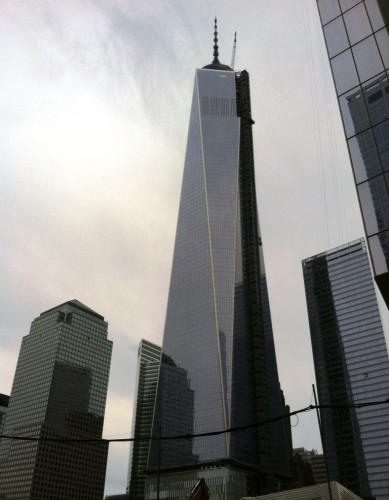 Here I share my journey from the Fulton Street Station through the Memorial.
Here I share my journey from the Fulton Street Station through the Memorial.
When arriving in the general vicinity, the first thing you see is One World Trade Center, originally called Freedom Tower. At 1,776 feet, the building stands as America’s tallest structure and 3rd tallest in the entire world. The height is no accident. It was purposefully designed to reflect the date of the American Declaration of Independence. However, the tower is not part of the 9/11 Memorial.
The first step was to get tickets. To control crowds, the Memorial organization issues passes designating each visitor a specific visitation time. I walked over to the 9/11 Memorial Preview Site on Vesey Street which is located directly across from St. Paul’s Chapel. This 250+ year old Episcopalian Church sustained no damage during the attacks and became a refuge for first responders and rescue volunteers. It has remained a tourist destination and memorial site in its own right.
After getting my tickets, I continued down Church Street. The next stop was the New York Firefighters Memorial Wall located at the corner of Liberty and Greenwich Streets. This expansive bronze bas-relief reads, “Dedicated to those who fell and to those who carry on… May we Never Forget.” In 2006, the city dedicated the bronze memorial to the 343 New York City firefighters who lost their lives in the attacks.
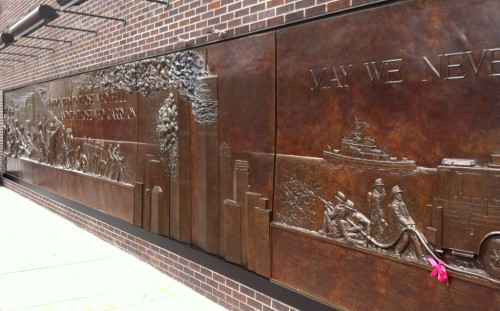
While I was stood there in silence I listened to an elderly gentleman who carefully polished one corner of the relief. As he painstakingly performed his self-appointed job he muttered to himself and anyone else listening. His lecture was about the events depicted. “We must remember,” he repeated. The emotion in his words was far louder than his voice.
After walking a few more blocks, I finally arrived at the entrance which was no less crowded than Disneyland in July. Roped-off lines wove back and forth ushering people this way and that. Finally, I reached the front of the line and was allowed “inside.” After turning a corner, I found myself in a makeshift corridor between the bustling city and a noisy World Trade Center construction zone. This chain link corridor made turn after turn after turn. Around every corner we had to show our tickets. After awhile I gave up on trying to figure out where I was. I could have crossed the river into Jersey City and not have known. I just kept showing my ticket in hopes that I was making some headway.
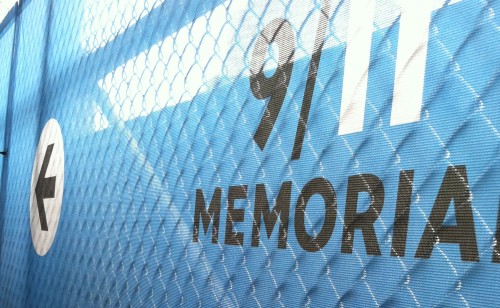
Around one turn, we found ourselves at security checkpoint which is tighter than anything the TSA could dream up. A piece of sage advice: Don’t try to take a photo in there!
Then, finally, we were… Nope, one more turn. One more ticket checkpoint.
Then we were finally released into the expanse of the memorial. The site is an impressive piece of flat land cradled by the surrounding skyscrapers. While it appears to be nestled safely in that space it also feels very exposed like a field in the middle of a dense forest.
The 9/11 Memorial itself is indeed a fascinating construction heaped with symbolic presence and deep meaning. It was designed by architect, Michael Arad and landscape artist, Peter Walker. Their winning proposal states it best:
This memorial proposes a space that resonates with the feelings of loss and absence that were generated by the destruction of the World Trade Center …. It is located in a field of trees that is interrupted by two large voids containing recessed pools. The pools are set within the footprints of the Twin Towers… They are large voids, open and visible reminders of the absence…. Standing there at the water’s edge, looking at a pool of water that is flowing away into an abyss, a visitor to the site can sense that what is beyond this parapet edge is inaccessible… The surface of the memorial plaza is punctuated by the linear rhythms of rows of deciduous trees, forming informal clusters, clearings and groves. ….. Through its annual cycle of rebirth, the living park extends and deepens the experience of the memorial… The memorial plaza is designed to be a mediating space.
The designers hit their mark. There is a definite starkness to the memorial. The two waterfalls are underscored with black stone which forces the eye downward into the deeper darkness of a secondary recessed pool. There is no fanfare, nor flowers or religious emblems. In those pools, there is only stone, water, the sounds of the city, the engraved names of the people lost and the sunlight shining from above. Arad and Walker have created a sacred space that, through its construction, leaves the visitor confronting an absence. In that way, the memorial is a sacred void.
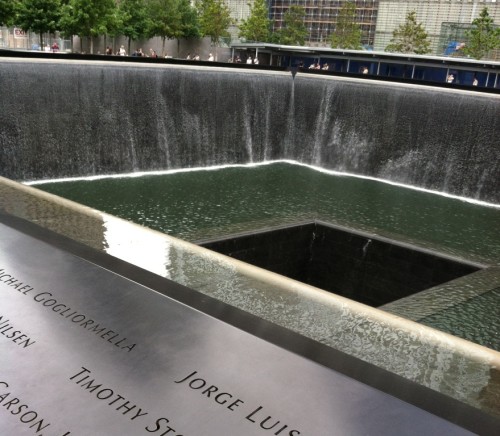
From my own theological perspective, I saw the pools as giant square cauldrons containing the waters of life, guiding the dead and calming the living. In this case, the cauldrons’ waters fall downward deep into Mother Earth where the water is then allowed to recycle back upwards to the top of the pool. It is liminal space between birth, death and rebirth, just as suggested by Arad and Walker.
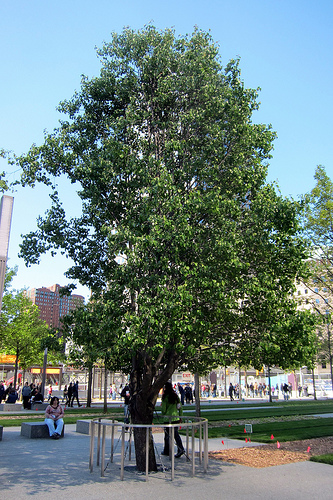
Drawing myself away from the pools, I went to visit the other main attraction – a tree. But not just any tree. It is the tree that lived. This tree was reduced to almost nothing when the towers fell. With human care, it was nurtured back to health and replanted at the memorial site. The Survivor Tree, as it is called, now thrives alongside all the new plantings. Once again we find the spirit of rebirth.
I can’t pretend to know what the 9/11 Memorial means to others – specifically to those who directly lost loved ones in the attacks. For me the memorial was not what I expected. I had hoped to find a place of calm where I could process my own lingering sadness. But I didn’t. I wanted the memorial to fill me with comfort and pride in my country. But it didn’t. Perhaps in time it will – when construction is done and the trees grow taller filling the stone space with more life. But not yet.
Or maybe the 9/11 Memorial will always rest as a sacred void – a point of liminality. Maybe the void is what needs to remain sacred. Through that absence, we remember.
After about one hour, I left the site feeling a profound, somber emptiness as if the last piece of the jigsaw puzzle was missing. Something still wasn’t right. It is amazing how the lack of something can be so powerful.
The Wild Hunt is not responsible for links to external content.
To join a conversation on this post:
Visit our The Wild Hunt subreddit! Point your favorite browser to https://www.reddit.com/r/The_Wild_Hunt_News/, then click “JOIN”. Make sure to click the bell, too, to be notified of new articles posted to our subreddit.

“From my own theological perspective, I saw the pools as giant square cauldrons containing the waters of life, guiding the dead and calming the living. In this case, the cauldrons’ waters fall downward deep into Mother Earth where the water is then allowed to recycle back upwards to the top of the pool. It is liminal space between birth, death and rebirth, just as suggested by Arad and Walker.”
What an incredible interpretation!
Let me rephrase my last sentence: What an incredibly wonderful interpretation!
That was a moving piece that really touched on something deep inside of me that I had not yet found words to describe.
I think the concept of the sacred void is something we all need to contemplate. So often we try so hard to fill the voids up with other stuff that we forget that the memories the void leaves us are as precious as the thing that use to fill the void in the first place. Like a person who has lost a loved one, you do not just fill up the void that their passing has left in your heart. Not if you wish to be truly happy in body, mind, and soul. Instead you build a sacred space for them in your heart that will always remain a place of rememberance and quiet contemplation. To fill the void is to try to forget, and to forget is to loose a piece of yourself. Forever.
Just remember, a hundred years from now no one will bother with it. It will just be a hole in the ground.
I don’t know about that. The events of 09/11/01 define how this century began for Americans. The fact that it led to two wars with Muslim countries will still be significant. It will be remembered like Gettysburg, PA is today, and that battle was more than 100 years ago.
I tend to agree, Cernowain. I expect 9/11 will be remembered at least until someone pulls off an even more lethal terrorist attack.
Charles, another likely scenario a hundred years from now is a hole in the ground ten feet below sea-level.
Thank you, Heather, for an inspiring and reflective piece. I was up in the twin towers many years ago, and have yet to visit the site again. Your words have encouraged me and prepared me to visit the memorial there.